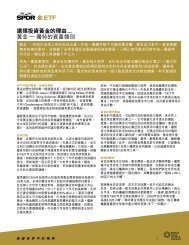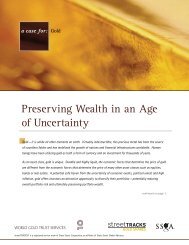Create successful ePaper yourself
Turn your PDF publications into a flip-book with our unique Google optimized e-Paper software.
ConclusionExchange-rate risk is a significant issue for investors allocatingassets abroad. Empirically, back tests show that exchangeratehedging provides benefits to developed market investorsthrough higher returns on emerging-market holdings, aswell as lower volatility across all global assets. However, thepast decade has brought significant changes in the globaleconomic landscape that have altered conventional wisdomabout exchange-rate hedging. As a result of robust growth inemerging markets and ongoing problems in developed markets,interest-rate differentials have once again been expanding andconsequently exchange-rate hedging costs have increased.Given the current trade-off between costs and benefits ofhedging, many investors might opt to leave their allocationsunhedged. After all, as globalisation expands, systemic risksmay appear as likely at home as abroad. However, whileemerging-market crises were regionally contained in the past,the increasing weight of these markets in global GDP, tradeand investor portfolios suggests a greater risk of contagion inany future crisis. In that context, there is a strong argument forsubstituting or complementing existing exchange-rate hedgingstrategies using gold.<strong>Gold</strong>’s foreign-exchange-hedging characteristics are uniqueand represent an additional benefit to a strategic allocation. Itis critical to note that our body of research has shown that anallocation to gold in the range of 2-10% is optimal for investorsacross a band of risk appetites. <strong>Gold</strong>’s foreign-exchange hedgingcapabilities further emphasise its versatility as a portfoliocomponent.Given the low cost of a gold allocation – from transaction,monitoring and carry perspectives – its positive relationship withthe emerging-market growth cycle and its application as atail-risk hedge, gold makes an attractive alternative to traditionalexchange-rate hedging programmes. Results of our analysisshow how gold can reduce portfolio drawdown for investorswith emerging-market allocations relative to a foreign-exchangehedge. In addition, gold as a discrete allocation increases riskadjustedreturns by lowering volatility. The most effective periodfor this strategy has been the last decade, not merely becausegold has been in a rising price environment, but because globalcrises have garnered a greater response from gold than before.Emerging-market currencies have been rising and interestratedifferentials have been growing. This environment seemsset to stay for the foreseeable future but, most importantly,with emerging markets becoming an increasing feature onthe landscape, investors need to protect their holdings againstunforeseeable risks. <strong>Gold</strong>’s proven tail-risk hedging propertiesmake it a powerful complement to a foreign-exchange hedge foremerging markets.34_35










